How Long Does Homemade Lard Last in the Fridge?
How long does homemade lard last in the fridge? Home-rendered lard is a terrific cooking fat that I regularly use. Plus, it’s easier to make a huge batch of lard than butter!
Lard from the grocery store has an expiration date on the package, but homemade lard doesn’t. So how long does it last?

This post contains affiliate links. As an Amazon Associate I earn from qualifying purchases. That means I make a small commission at no cost to you if you place a qualifying purchase through any of the links. Read my full disclosure here. Thanks for your support!
This post is a tutorial on how to make and store lard for later use in traditional home cooking. We will also go into how long lard lasts when it’s in the refrigerator, freezer, pantry, or sitting out on your kitchen counter.
I love using animal fat like butter, lard, schmaltz, and tallow. I also avoid hydrogenated vegetable shortening because it is so highly processed and known to have negative health consequences.
If you’ve never rendered lard before, I want to encourage you to try it! It’s a very simple process that I’ll explain in detail in this post.

What is lard?
Lard is a type of fat that comes only from pigs. It is pork fat that has been melted on low heat until all of the water has evaporated out of it, and the fat separates from the meat tissues (“cracklings”).
Lard is similar to butter in that it is solid at room temperature. It is white with very little pork flavor, and is a stable fat which makes it a great option for deep-fat frying.
The book Nourishing Traditions goes into detail on fats including lard. All fats and oils are a combination of saturated fatty acids, monounsaturated fats, and polyunsaturated linoleic acid and linolenic acid. Lard is 40 percent saturated, 48 percent monounsaturated, and 12 percent polyunsaturated fats. There are no trans fats in lard (or other animal fats).
We like to raise pigs in a natural way, where they eat organic food and scraps, and they have plenty of room to run around on the farm being a pig. The resulting fat when it comes time to harvest the pigs is very dense and beautiful. It’s nothing like factory-raised pigs that have squishy fat.
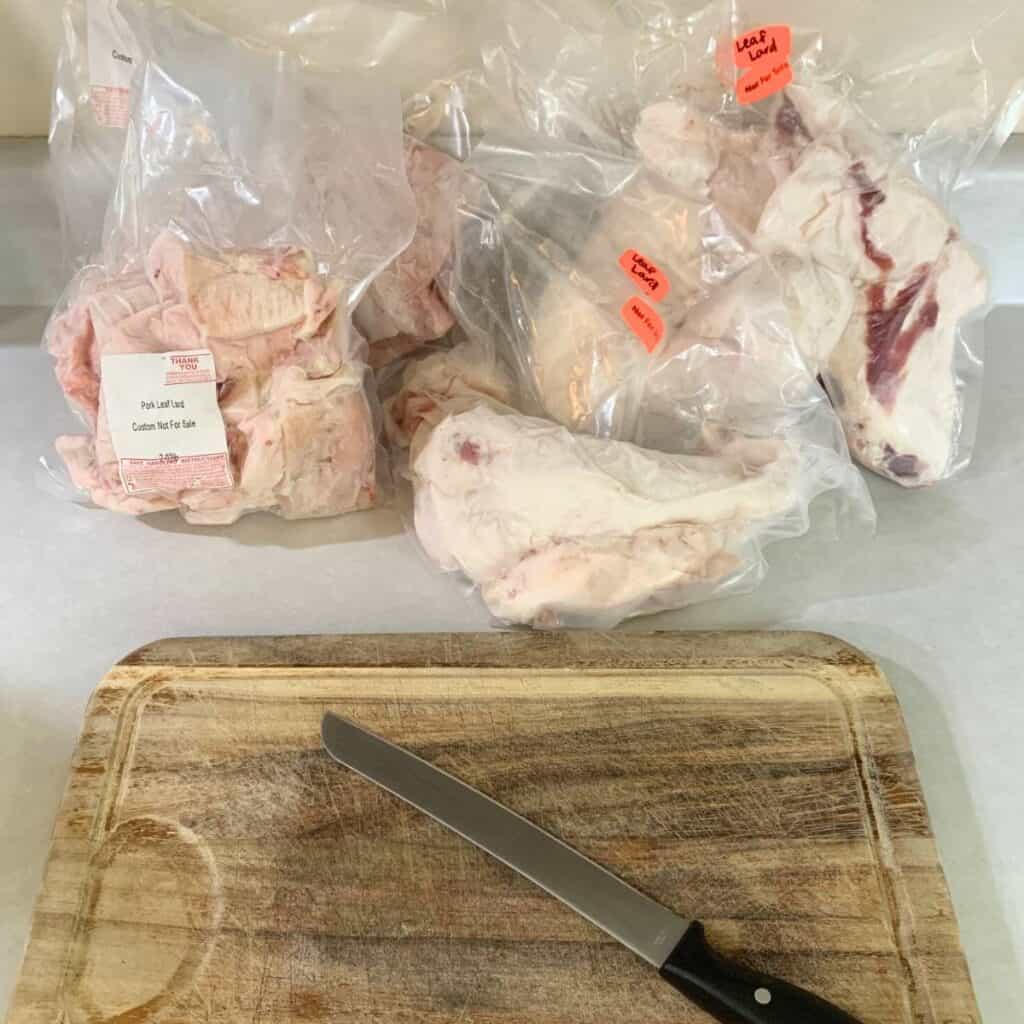
For example, when I took our three pigs to be harvested earlier this year, the butcher commented on the quality of the fat, how dense the fat was, and how pure-white it looked. He had never seen pig fat like that.
My friends, the better you raise your pigs, the healthier every part of the pig is. Everything from the meat and organs, to the fat.
What is leaf lard?
Leaf lard is a type of lard that is made from the small amount of pig fat that surrounds a pig’s kidneys. It’s known as the best quality of lard because it is the whitest, has a neutral flavor, and is highly prized for making flaky pie crusts.

How long does homemade lard last?
With proper storage, pure lard in a tightly sealed container can last for years. But lard’s shelf life is dependent on how it is prepared, handled, and stored.
How long does homemade lard last in the fridge?
Unopened lard can last over 18 months in the fridge as long as it was prepared and handled properly, and stored in an air-tight container.
How long does homemade lard last in the freezer?
Lard can last for years in the freezer in long-term storage. The good thing about freezing your lard is that even if you didn’t do a perfect job on rendering your lard, the freezer is very forgiving.
If some of the water content is still in the lard, the freezer stops mold growth and other nasties from forming. Freezing lard is the easiest way to keep your lard from going bad.
How long does homemade lard last in the pantry?
Homemade lard can last anywhere from 6 months to 1 year in the pantry as long as it was prepared, handled, and stored properly.
You can pressure-can your lard in glass mason jars if you want to give some jars away as gifts. Store-bought lard isn’t the best-tasting and homemade lard is always preferable.
If you don’t have any spare refrigerator or freezer space, a kitchen cabinet is a good alternative storage location.
I don’t bother with canning my lard. Since I’m meticulous about using sanitized glass jars and lids, my homemade lard lasts just fine up to a year on a pantry shelf! You do always want to look out for signs of mold when it’s time to get another jar off the shelf, though.
How long does homemade lard last out on the counter?
Homemade lard and leftover lard can last up to a couple of weeks on your kitchen counter in a closed container. That’s fine if you’re storing your lard in a small enough container that you’ll use up before it goes bad.
Here’s an important point: You can always refill your lard container with lard from your fridge.
I don’t have any recipes that need room-temperature lard, so I always keep my lard in my refrigerator when I’m using it. Otherwise, unopened jars of lard are kept in my pantry or in my spare fridge.
Process to make fresh lard.
Making regular lard is a simple and straight-forward process.
- Defrost your frozen pig fat.
- Chop the pig fat up into small pieces.
- Melt the fat over low heat until the fat is rendered out.
- Optional: Whiten the lard.
- Skim off the cracklings.
- Strain and decant the lard.
- Cool the lard down.
- Store your lard in a cool, dark place.
1. Defrost your frozen pig fat.
First, get your packages of frozen pig fat out of your freezer and set them on the counter to thaw.

2. Chop the pig fat up into small pieces.
You can use a wooden cutting board and sharp knife for this or a meat grinder.
The goal is to chop up the pig fat into small portions or small cubes so that the fat will render out more quickly.

If you want plenty of cracklings at the end of the process, keep larger chunks of pig fat.
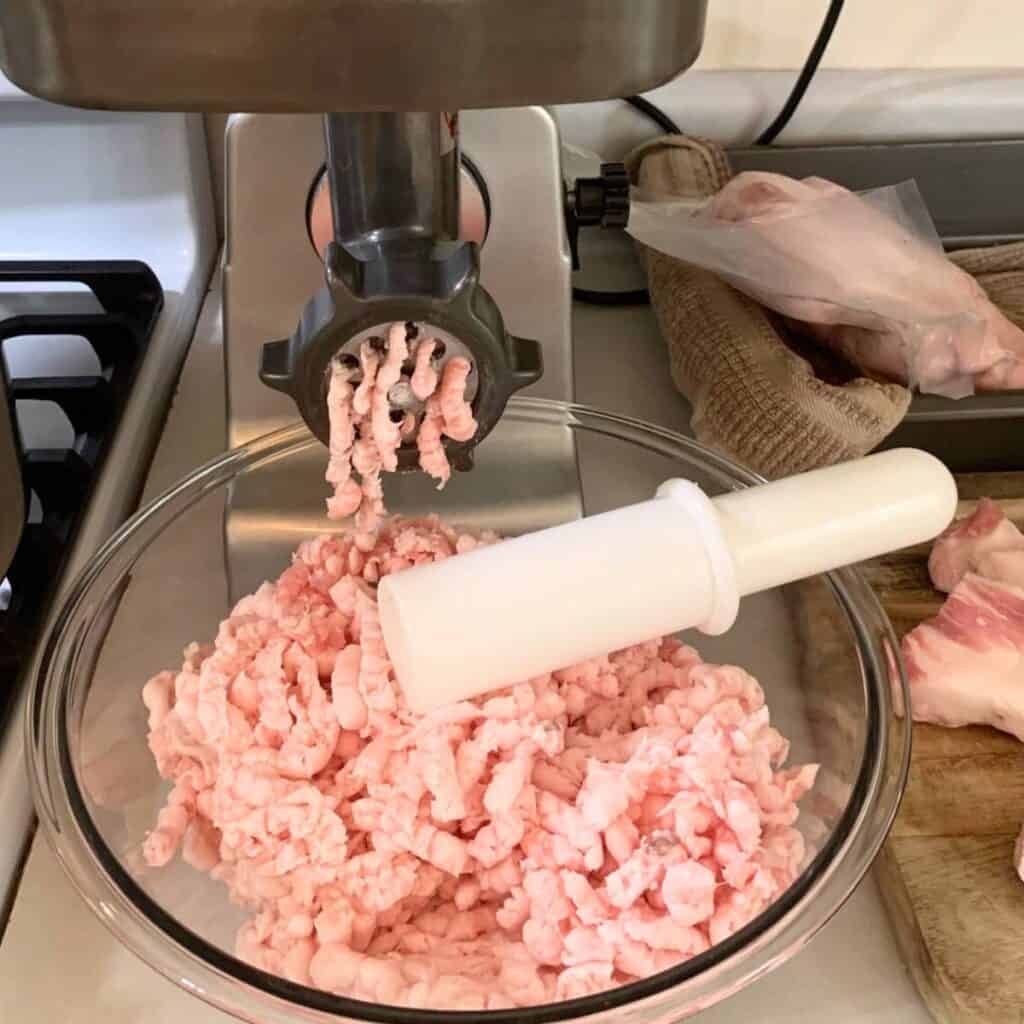
If you don’t care for cracklings, grind up the pig fat.
3. Melt the fat over low heat until the fat is rendered out.
Heat the pig fat in a heavy-bottomed pot or in a low to moderate oven. It may take anywhere from a few hours to render the fat into lard, and it may take over 24 hours to get all the fat rendered down.

Side of caution: Keep your face away from the hot oil. It will pop every once in a while as the water evaporates!
You’ll notice that the pig fat will melt and become a liquid. Excess water will bubble up and evaporate out of the hot oil.
As your hot oil condenses, it will bubble less and less.
4. Optional: Whiten the lard.
If you want to end up with the whitest lard you can get, add 1/2 teaspoon of baking soda to the pot when the lard is starting to be rendered out. Alternatively, you can add a raw potato to the liquid lard, stir it around for a few minutes, and then remove the potato.
I never do this because my lard turns out pretty white almost all of the time. Still, it’s worth noting.
5. Skim off the cracklings.
When the cracklings are a golden brown color and are floating at the top of your lard, scoop them out and drain them on a paper towel-lined baking sheet. Add some delicious sea salt for a nice snack!

If you don’t skim off the cracklings, they will sink to the bottom of your pot and burn. That will give an undesirable flavor to your lard and also turn it a darker color.
6. Strain and decant the lard.
If you have a lard press, you can pour your finished lard into the lard press and then into your lard containers. I don’t have a lard press, so I just put a stainless steel funnel into my sanitized glass jars and rest a fine mesh sieve in it.
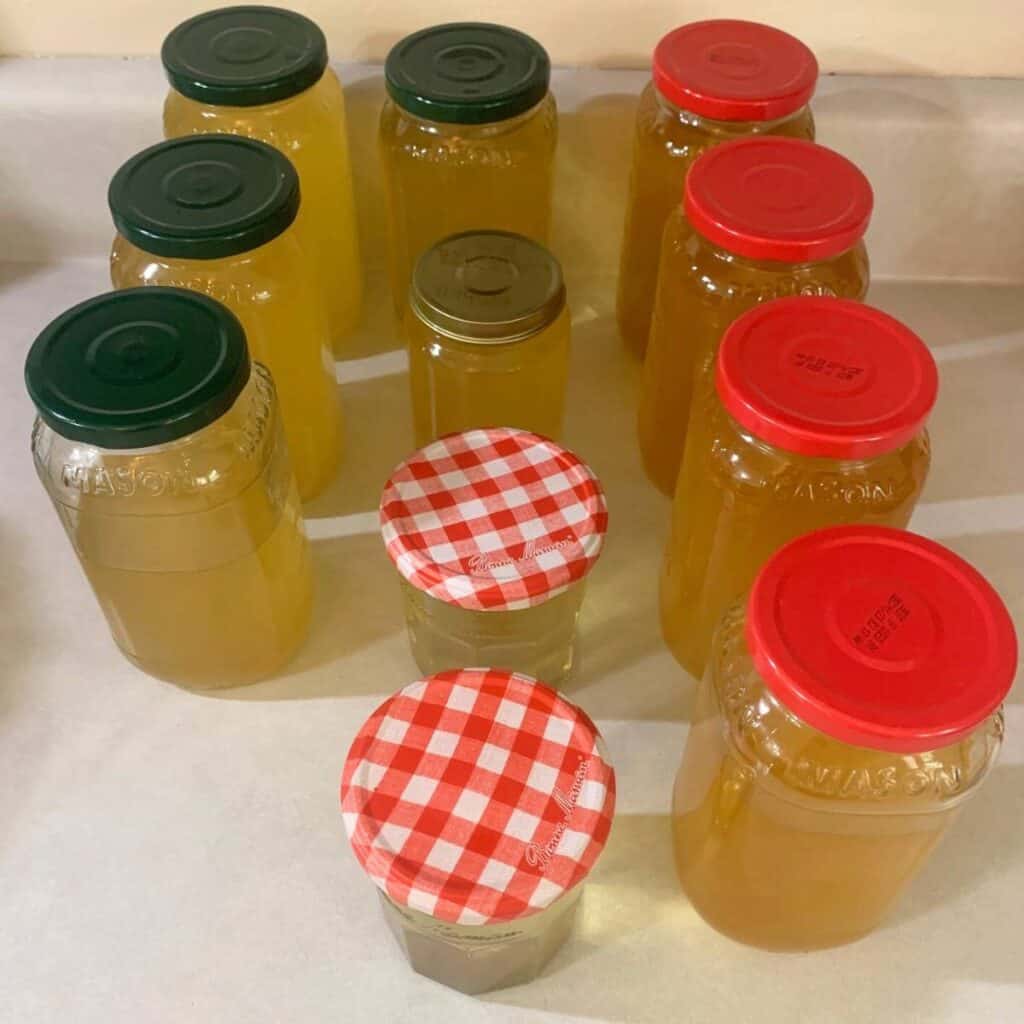
Then I’ll pour the liquid lard into the jar and leave about an inch of headspace at the top before tightening a lid on top.
As the jars cool down, the lids get sucked down to seal the jar in a vacuum.
7. Cool the lard down.
When your lard is strained and decanted, cool it down. The quicker your lard cools down, the better quality of the lard. Cooling lard down quickly improves the texture of the lard and it will be less gritty.
I don’t put my hot lard into the fridge because it will harden a little wonky and buckle. I wait for my lard to cool down on my countertop, usually overnight. Then the next morning I’ll move the cooled jars to my pantry or to my spare fridge.
8. Store your lard in a cool, dark place.
Storing your lard in the right place will make all the difference between your lard lasting one month or one year or more.
If you want your lard to last years, store it in your freezer in usable portion sizes. You can also store lard in jars in a spare fridge and it’ll last for over a year.
Can lard go bad?
Lard goes bad when it is left out at room temperature for a long period of time. Signs of spoilage include the presence of mold, rancid smell, sour smell, and bad taste.
If your lard is kept out at room temperature and is exposed to direct sunlight and even artificial lights, your lard won’t last very long. We’re talking maybe a couple of weeks if your house is around 70°F (21°C).
Additionally, if you aren’t using clean utensils to get lard out of your lard container, you’ll have a much shorter shelf life.
If home-rendering lard isn’t your thing, a tub of lard that you buy from the grocery store will have a best-by date, expiry date, use-by date, or expiration date. It’s a good idea to follow original packaging instructions for how to store your lard so that it will keep for a long time.
Uses for rancid lard.
Air and light cause chemical changes that make your fresh lard become rancid. If you find that some of your jars of lard went bad, you definitely don’t want to risk food poisoning by eating the lard. Food products made from rancid lard will make you sick!
However, here are some things that you can still use your rancid lard for:
- Make your own soap. Soap recipes call for a fat and the fat most often used is lard. However, it doesn’t have to be fresh lard. Rancid lard still works to make fine soap!
- Make your own lard-based products like lotions and salves. I’ve never used rancid lard for this but it’s definitely an option. If you like making your own body products, save your coconut oil and use expired lard the next time you start a project. You probably will have to add a bit more essential oil to make it smell better, though. Just guessing.
- Waterproof any fabric or object. Water rolls right off fat because water and oil don’t mix. We’ve used rancid lard to waterproof boots before. This is especially great during winter when it snows.
- Grease tight hinges. My door hinges are notorious for squeaking, but lard seems to fix the problem without creating too big of a mess.
What is the best way to store lard for a long shelf life?
Store lard in a dark, cool place or freezer, in an airtight container such as a freezer bag or glass jar with a tight-fitting lid, for a longer shelf life.
I like to store my lard in sanitized glass jars with a tight-fitting lid. For this, I just save and reuse old pasta sauce jars and lids that I get from the grocery store. They are so handy for lard because you need a ton of containers for even just one pig’s lard.
If you don’t have tons of reusable glass jars or mason jars, you can also pour your rendered lard into a separate glass pan, and store it in the fridge until it cools and hardens. After it hardens, you can cut the lard into large chunks and wrap it in a double-layer of butcher paper, parchment paper, or wax paper, and put it into a freezer bag. This option would save a lot more space in the freezer.
Lard freezes beautifully. But freezing dozens of jars of lard depends on how much spare room you have in your freezer. Since I don’t have a ton of extra freezer space for lard, I keep my jars in our extra fridge and on my pantry shelf.
Keeping your lard in a cold temperature-controlled environment will increase the shelf life of lard significantly.
Why is my rendered lard dark?
The most common reason for home-rendered lard to have a dark color and not be snowy white or creamy white, is because there were bits of pig meat (“cracklings”) along with the fat and the meat got burned.
Cracklings sink to the bottom of the pot when they are done cooking. Then they scorch and turn a dark color, which also darkens your lard. You want to make sure to cut the meaty parts off your lard whenever possible, before you render your lard.
Another possible reason for a dark-colored lard is that you used fat from around the internal organs. This fat is known as the “caul” and “ruffle” fats. Using this fat results in darker lard.
Pin It For Later!

Shop This Post
Nourishing fats: why we need animal fats for health and happiness, by Sally Fallon Morell


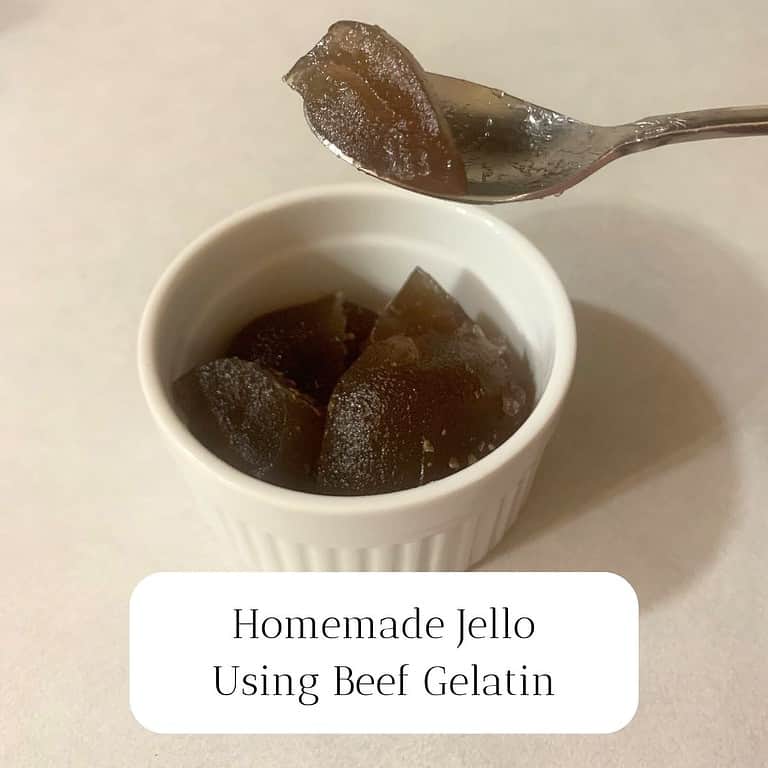
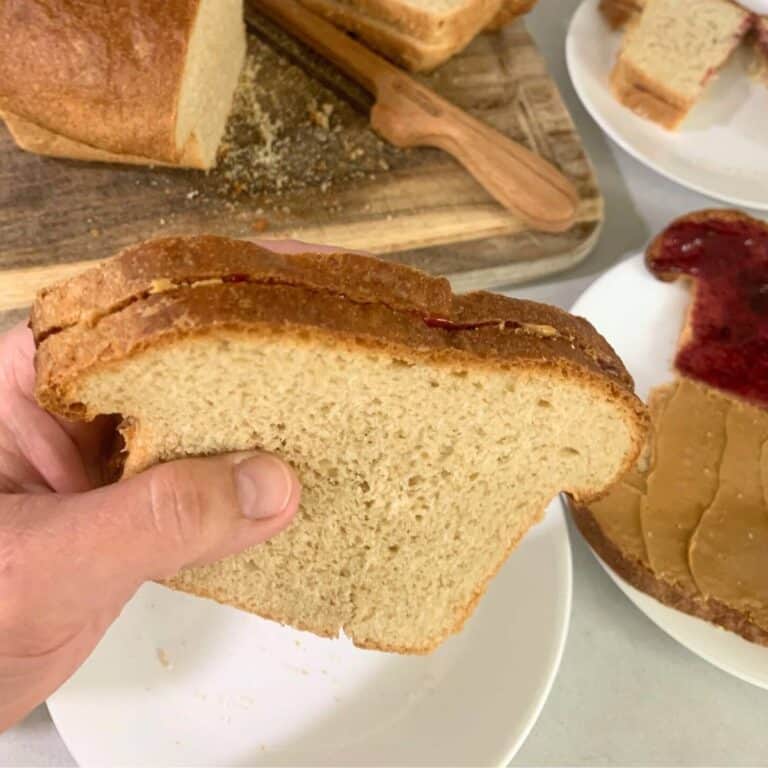

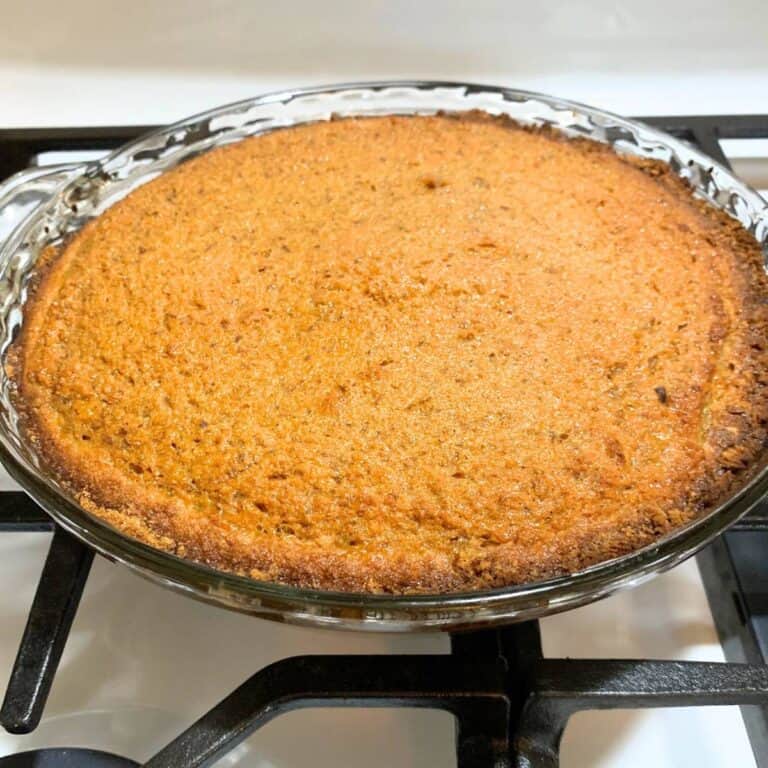

Such helpful information! This is awesome, thanks for sharing!
You’re welcome!
This was super helpful! Thank you for sharing!
I’m happy to help!
Such great information. I really want to make my own lard, I just need to make the time to do it. Great post Rebekah 🙂
Thank you Dusty! The good news is that it doesn’t take that much hands-on time to make the lard, and then you will probably be set for the year!
I always wondered, and now I know! Thank you for putting out such informative content!
You’re very welcome!
Very useful info!! I had no idea. Thank you for sharing 🙂
You are most welcome!
Rebekah – This was SO informative, thank you. I just learned how to make pies and like the Crisco version the best instead of butter? Could I use this type of lard in place of Crisco? I’m thinking yes but thought I would ask since I’m still learning the world of pie crusts, but loving this new skill and all the recipes you can make by knowing how to make a pie crust. Thanks!
Yes, you can absolutely use lard instead of Crisco! Butter pie crusts are delicious but I find that even using half butter and half lard makes it so much better and flakier. Using 100% leaf lard will give it that extra something special, though. Good luck with your new skill and I hope you have delicious results Nikki!
Cool, I’m going to try this. Thank you so much.